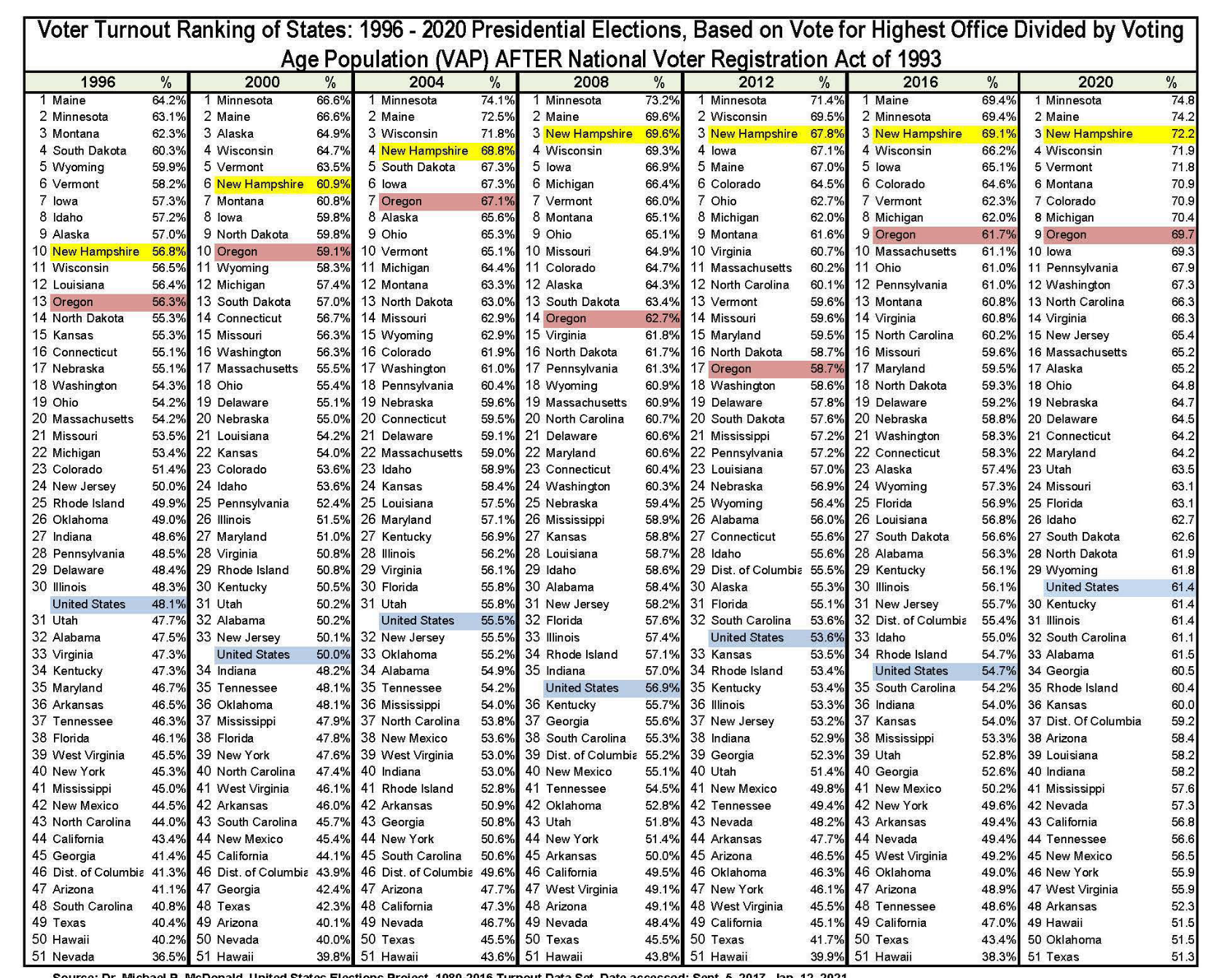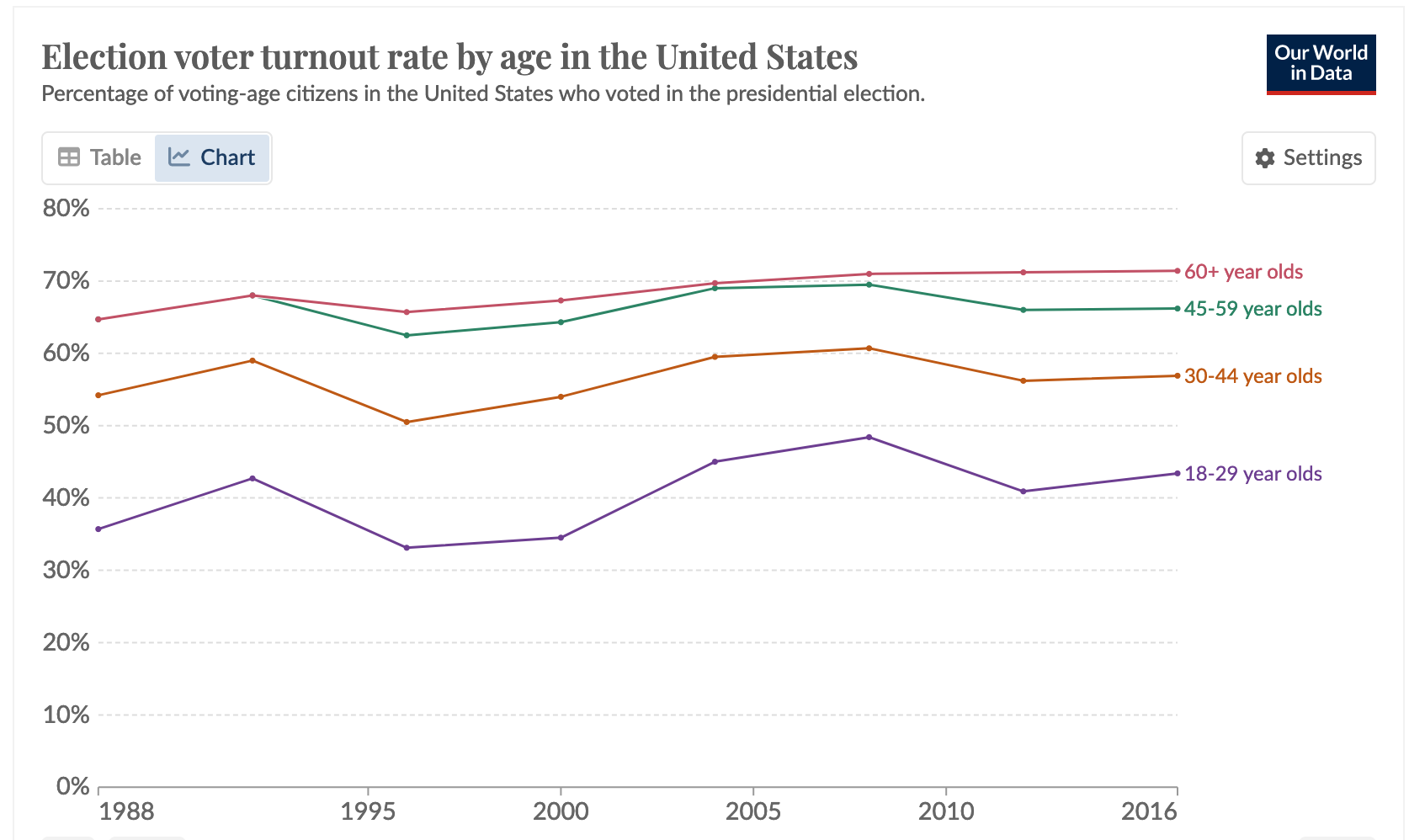Oversample Elections By Age
Political pollsters have a problem. Certain groups in the population are much happier to talk to pollsters than others, so if you call up 1000 people to ask who they're planning to vote for, the results you get won't really represent the voting intentions of the population at large. So the pollsters do something called "oversampling": if they know that (say) young voters are only half as likely to respond to polls as older voters, they double-count the responses from the young people who do pick up the phone, to try to get a better read on things.
(Of course, this has its own problems: maybe young-people-who-answer-phones are not representative of young-people-in-general, etc – pity the poor pollsters who have to deal with this).
I've never heard it described this way, but a kind-of version of oversampling happens in many actual elections.
For example, the US Presidency is famously decided not by a National Popular Vote – that is, whichever candidate gets more votes in the country as a whole, wins – but by an Electoral College system where each state sends a number of electors determined by its number of Senators and Congresspeople.
This system has various consequences I won't go into here, but one rarely-discussed consequence is a kind of de-facto oversampling of voters from states with low turnout:

For reasons entirely unclear to me, this charming PDF from the office of the New Hampshire Secretary of State is focused mainly on the fact that, since 1996, New Hampshire's turnout has been beating, specifically, Oregon's (up yours, Oregon!). But for our purposes, the point is only that for 20+ years the highest turnout state has consistently seen ~50% higher voting rate than the lowest-turnout state.
Now, it would be entirely wrong to say that a voter in a low-turnout state has "50% more impact" than a voter in a high-turnout state. First, unless you're in an election where the winner is decided by exactly one vote, there's some sense in which the direct marginal impact of one more vote is basically zero regardless; second, the electoral college is not a direct representation of the number of voters in a state: each state also gets one electoral college vote per Senator, and every state has two Senators regardless of population, so small states get proportionately more votes per person. That difference is larger than the difference in turnouts: Wyoming has one vote per 200,000 residents, while California has one vote per 700,000 residents.
Nonetheless, one component of the election is effectively "geographic oversampling" of voters in low-turnout states: if you're from a state with low voter turnout and you actually show up to vote, in some sense your vote is up-weighted as if it "represents" some of your neighbors who didn't vote.
If someone had to justify this practice, the logic would go something like this: we think that people living within some geographic unit share some amount of common interests, and we want to make sure that those interests get represented in the final choice of President, including the people who didn't show up to vote.
In theory, we could implement a similar system based on other population groupings. There are plenty of such groupings that would be pretty obviously objectionable and unworkable. Most groups lack either the kind of objective, legible boundaries that you need in order for stratification to work, or lack the kind of shared interests that would make it philosophically coherent for us to think the voting members of the group can even vaguely represent the non-voting members, or both.
Still, I'd like to propose one grouping that I think is both sufficiently objective and has enough shared interests to qualify: age-mates. [Please think of this as more of a thought experiment than a policy proposal].
Imagine we stratified the voter pool by age groups: 18-27, 28-37, 38-47 and so on. We would look at census data and allocate electoral college votes to each age group according to the total population within each age group. Then, when people go to the polls, the electoral college votes within each band would be allocated according to the vote-share among the voters in that age-band.
What would be consequence of this?

Well, currently 60+ year olds vote at a rate over 50% higher than 18-29 year olds. So an Electoral College By Age would give vastly more power to candidates preferred by younger voters, at the expense of candidates preferred by older voters.
I think the obvious counter-argument to this proposal is: if younger voters don't turn out, why do they deserve to be represented? But I think this depends on your model of what elections are for. To the extent that elections are supposed to represent The Will Of The People, a system that tries to represent the interests of non-voters makes some sense – and of course, the best way to ensure your own view is represented would still be to turn out and vote.